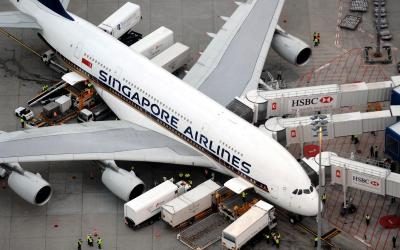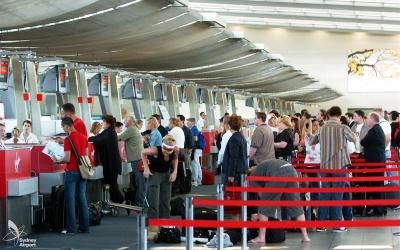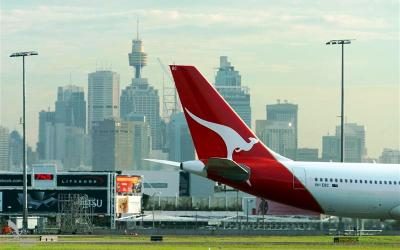Sydney’s Kingsford Smith Airport is the busiest airport in Australia, handling 35.6 million passengers last year – an average of 97,400 passengers each day. It is located about eight kilometres south of Sydney’s CBD and convenient transport to the city is available by both road and rail. By facilitating international trade and communications, efficient airports are vitally important to Australia’s national prosperity. They are an essential part of the transport networks that all successful modern economies rely on.
There are three passenger terminals and a dedicated freight area at Sydney Airport:
T1: International Terminal - as at December 31, 2010, T1 was used by 37 international airlines flying to 48 destinations around the world.
T2: Domestic Common User Terminal - this terminal is used by domestic and regional airlines including Jetstar, Virgin Blue, Regional Express, Tiger Airways, Aeropelican, QantasLink and Brindabella Airlines.
T3: Qantas Domestic Terminal - this terminal is operated by Qantas and used for Qantas domestic flights.
Freight - there are seven cargo terminals controlled by five cargo terminal operators. Approximately 80 per cent of freight is carried in the holds of passenger aircraft with the remainder transported in dedicated freight aircraft. More than 470,000 tonnes of freight were handled in 2007. Exports include fresh, chilled or frozen perishables such as meat, seafood and fruit as well as manufactured items. Imports are typically high value manufactured items such as computers and car parts. Sydney Airport is one of the oldest continually operating airports in the world. In 1919 the Australian Aircraft and Engineering Company leased land from the Kensington Racing Club and established an aerodrome at Mascot. A canvas hangar was built and the first aircraft was assembled. The first flight took place in November 1919 when Nigel Love took off and circled the aerodrome. By the mid-1920s regular air services between Sydney, Melbourne and Adelaide were underway and the Australian Government had taken control of the airport. In the 1940s a passenger terminal was opened and the Cooks River was diverted to allow for the construction of two new runways.
Sydney Airport is one of the oldest continually operating airports in the world. In 1919 the Australian Aircraft and Engineering Company leased land from the Kensington Racing Club and established an aerodrome at Mascot. A canvas hangar was built and the first aircraft was assembled. The first flight took place in November 1919 when Nigel Love took off and circled the aerodrome. By the mid-1920s regular air services between Sydney, Melbourne and Adelaide were underway and the Australian Government had taken control of the airport. In the 1940s a passenger terminal was opened and the Cooks River was diverted to allow for the construction of two new runways.
In 1963 work commenced on the construction of the extension of the north-south runway southwards into Botany Bay and in 1965 work commenced on the construction of the International Terminal. In 1989 the parallel (or third) runway was approved and was completed in 1994. The Australian Government privatised Sydney Airport Corporation Limited in 2002. As one of Australia’s single most important pieces of infrastructure, Sydney Airport is a major employer and economic driver. It makes a direct contribution of $8 billion in NSW Gross State Product. With flow-on impacts taken into account, the airport’s economic contribution increases to $16.5 billion.
As one of Australia’s single most important pieces of infrastructure, Sydney Airport is a major employer and economic driver. It makes a direct contribution of $8 billion in NSW Gross State Product. With flow-on impacts taken into account, the airport’s economic contribution increases to $16.5 billion.
Sydney Airport’s airfield has been progressively expanded and modified in response to traffic growth and changes to fleet mix and aircraft size. The airfield consists of parallel runways in a north-south direction, an east-west runway, taxiways and aircraft parking aprons and supporting infrastructure.
The main north-south runway is 3,962 metres long, the parallel runway is 2,438 metres long and the east-west runway is 2,530 metres long. The two north-south runways are equipped with High Intensity Approach Lighting (HIAL) systems and all runways are equipped with Instrument Landing Systems (ILS).
 The runways are supported by a taxiway system designed to facilitate the efficient movement of aircraft between the runways and terminals areas. Rapid Exit Taxiways (RETs) are provided on the parallel runways to minimise occupancy time.
The runways are supported by a taxiway system designed to facilitate the efficient movement of aircraft between the runways and terminals areas. Rapid Exit Taxiways (RETs) are provided on the parallel runways to minimise occupancy time.
Aprons are areas provided to facilitate aircraft parking stands. There are currently 41 stands for international and freight operations and 57 stands for domestic and regional operations. Sydney Airport accommodates operations by the full range of aircraft codes with Code C (A320, B737), Code D (B767), Code E (A330, A340, B777 and B747) comprising the majority of operations. Code F services are operated from T1 by A380 aircraft. The main north-south and east-west runways and their supporting taxiways have been upgraded to accommodate operations by aircraft up to and including the A380.
This year the airport has seen the introduction of a number of new services, although the arrival of Hainan Airlines in January and Qantas’ expansion to Dallas DFW International in May were the two main network developments.





